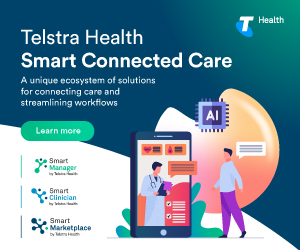Update to NSQHS Standards for day hospitals and private surgeries
The Australian Commission on Safety and Quality in Health Care (ACSQHC) announced in 2023 that healthcare facilities who are accredited to the National Safety and Quality Health Service (NSQHS) standards will have to develop a plan for implementing systems that can provide information to the My Health Record (MHR) platform.
Advice from Australian Commission on Safety and Quality in Health Care (ACSQHC)
All public and private hospitals, day procedure services and public dental practices are required to be accredited to the National Safety and Quality Health Service (NSQHS) Standards.
Many other healthcare facilities will also choose to be accredited in order to improve the safety and quality of health care provision. When seeking assessment to the NSQHS Standards, health service organisations must review and provide evidence against Advisory AS18/11.
Actions 1.17 and 1.18 of this advisory relate to health service organisations implementing systems for the use of the My Health Record system, including:
- Creation of an implementation plan for connection into My Health Record by December 2023
- Work towards connection into My Health Record by December 2024
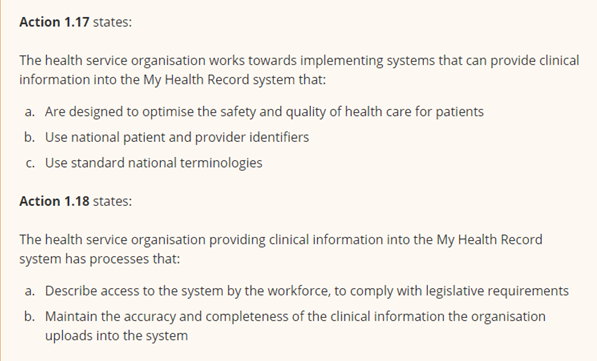
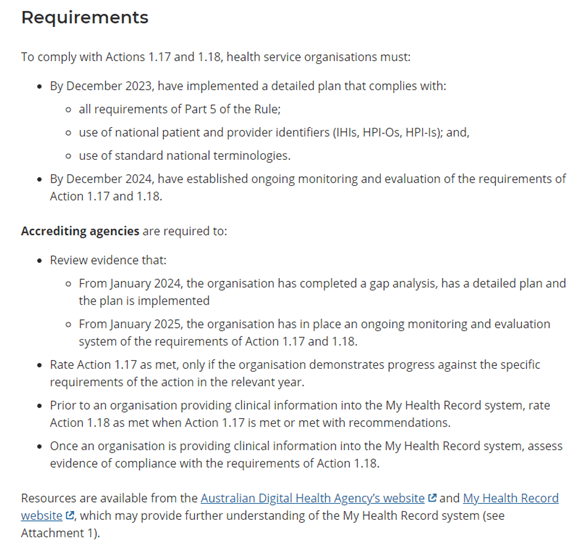
For private hospitals, day surgeries and specialist practices with a surgical component, attention should be given to these deadlines. According to The Commission, a comprehensive gap analysis should have been completed by December 2023, as part of ongoing planning for MHR connection.
The Australian Digital Health Agency (ADHA) said managers should operate under the assumption that they might be accredited at short notice, and therefore should be able to provide evidence to demonstrate the planning steps undertaken and their readiness for MHR connectivity. ADHA has suggested the following planning stages, including what essential documentation should be provided as evidence for accreditation. This is especially important in cases where accreditation is not pre-planned and happens at short notice.
Strategic guidance for specialist practice and day surgery managers
1. Engagement with ADHA
Contact the Australian Digital Health Agency (ADHA) for support on MHR connection, including PRODA registration and software options.
Record details of interactions, including the team (e.g. Partnerships, Education), what was discussed and next steps.
2. Connection methodology
To connect to My Health Record you’ll need to use an electronic health record (EHR) software that is conformant with the My Health Record platform.
You should determine your preferred method of MHR connection based on your needs and keep documentation relating to selection criteria and decision making.
It is vital to select a solution that is conformant with MHR. MedicalDirector Clinical, which is used alongside half of all practices using Bluechip practice management software is conformant with My Health Record.
If you’re using another software product to manage clinical notes, you can check here to see your if your EMR software is conformant with My Health Record.
If you want to learn how to get started with MD Clinical, including connecting to My Health Record and seamless integration with MD Bluechip, visit our website.
3. Operational use strategy
Develop a clear plan outlining the intended use of MHR within the facility, such as viewing and uploading discharge summaries.
4. User integration plan
Define who will be using MHR and define user type (admin, view-only, upload). Devise a phased approach for MHR usage, suggest starting with administrative staff, followed by nurses, and then clinicians.
5. Staff education and training
Create and document an educational plan for all staff members prior to MHR connection.
6. Security policy
Update your Security and Access Policy using this checklist from ADHA, ensuring it is ready and available before MHR connection is established.
Suggested timeline for implementation (guidance only)
By March 2024, Security and Access Policy created/updated.
By May 2024, determine method of MHR connection and ensure software is conformant.
By August 2024, complete staff education for the initial cohort using MHR.
By October 2024, establish the MHR connection.
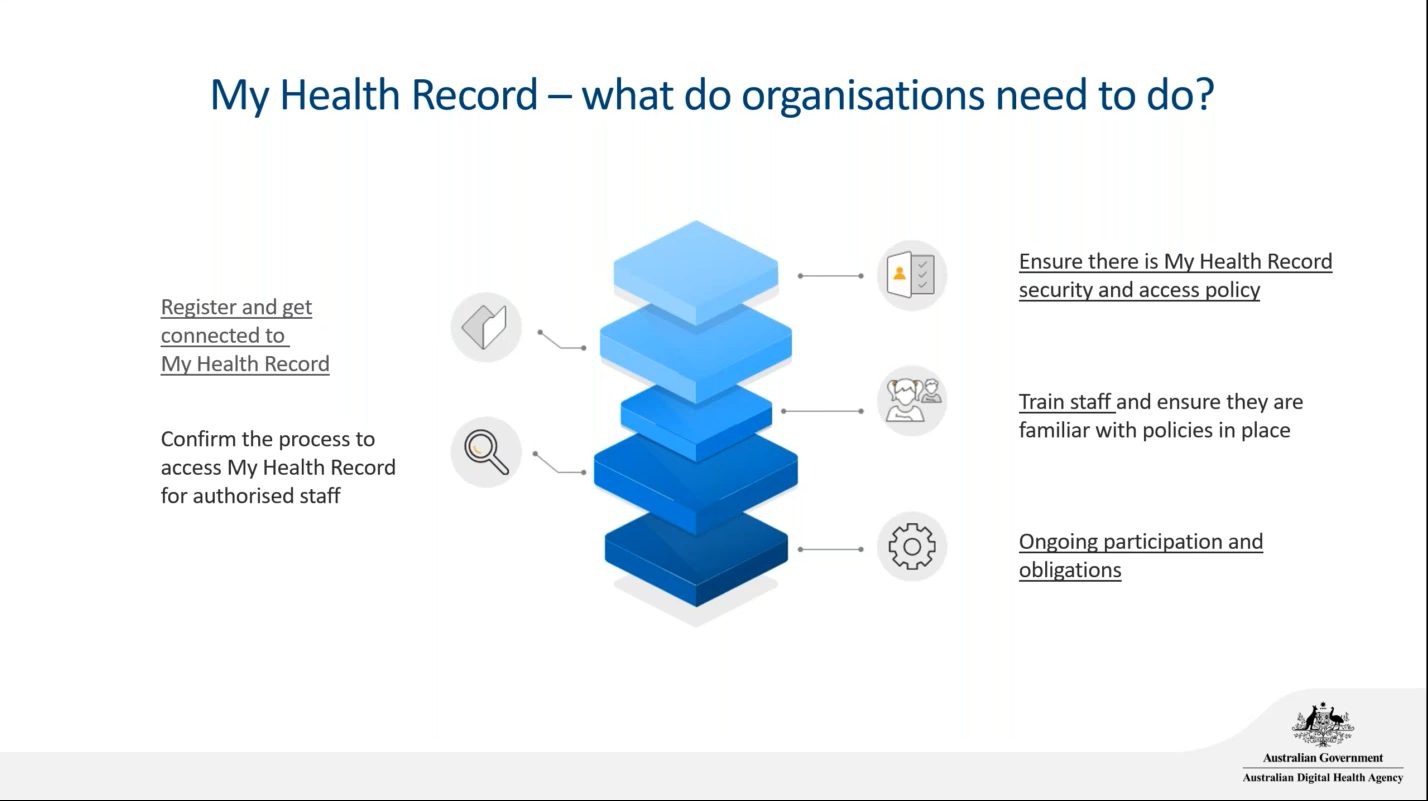
As we move toward a more connected healthcare ecosystem, it’s essential for day surgeries to not only meet the standards but to embrace them as an opportunity for improvement in patient care.
MedicalDirector Clinical, alongside Bluechip, is already conformant with MHR and serves as a model for software integration. For practices utilising other clinical software, verification of conformance with MHR is a crucial step.
With a clear, actionable plan for connection into My Health Record, such as using MedicalDirector Clinical, your practice will not only comply with the updated NSQHS standards but will also be equipped to deliver better healthcare information exchange and patient outcomes.
Support resources
Resources are available from the ADHA website which may provide further understanding of the My Health Record system including how to register and set up access: My Health Record for healthcare providers | Australian Digital Health Agency.
You can also access two webinar recordings by registering here:
Steps to setup My Health Record in PRODA in link to conformant software
- Identify a responsible officer (RO) within your organisation
- Create a PRODA account for the responsible office, any other administrators (‘organisation maintenance officer’ (OMO)), and any clinicians who will be using MHR (if they don’t already have one).
- Register your ‘seed organisation’ and obtain an HPI-O (Healthcare Provider Identifier – Organisation) with the Healthcare Identifier (HI) Service (this can only be done by the RO).
- Register any ‘network organisations’ to link to your seed organisation (multi-site organisations only)
- Link your Healthcare Provider Identifiers in HPOS (Health Professional Online Services) within PRODA:
- HPI-O Healthcare Provider Identifier – Organisation
- HPI-I Healthcare Provider Identifier – Individual (all clinicians)
- Request and download a NASH certificate (National Authentication Service for Health):
- Within HPOS go to: Healthcare identifiers > My organisation details > Certificate tab > Request a NASH PKI site certificate
- NASH certificates are valid for two years and can be requested or renewed by the RO or any OMO
- Link your NASH certificate in MD Clinical (or other conformant software) to turn on My Health Record access.
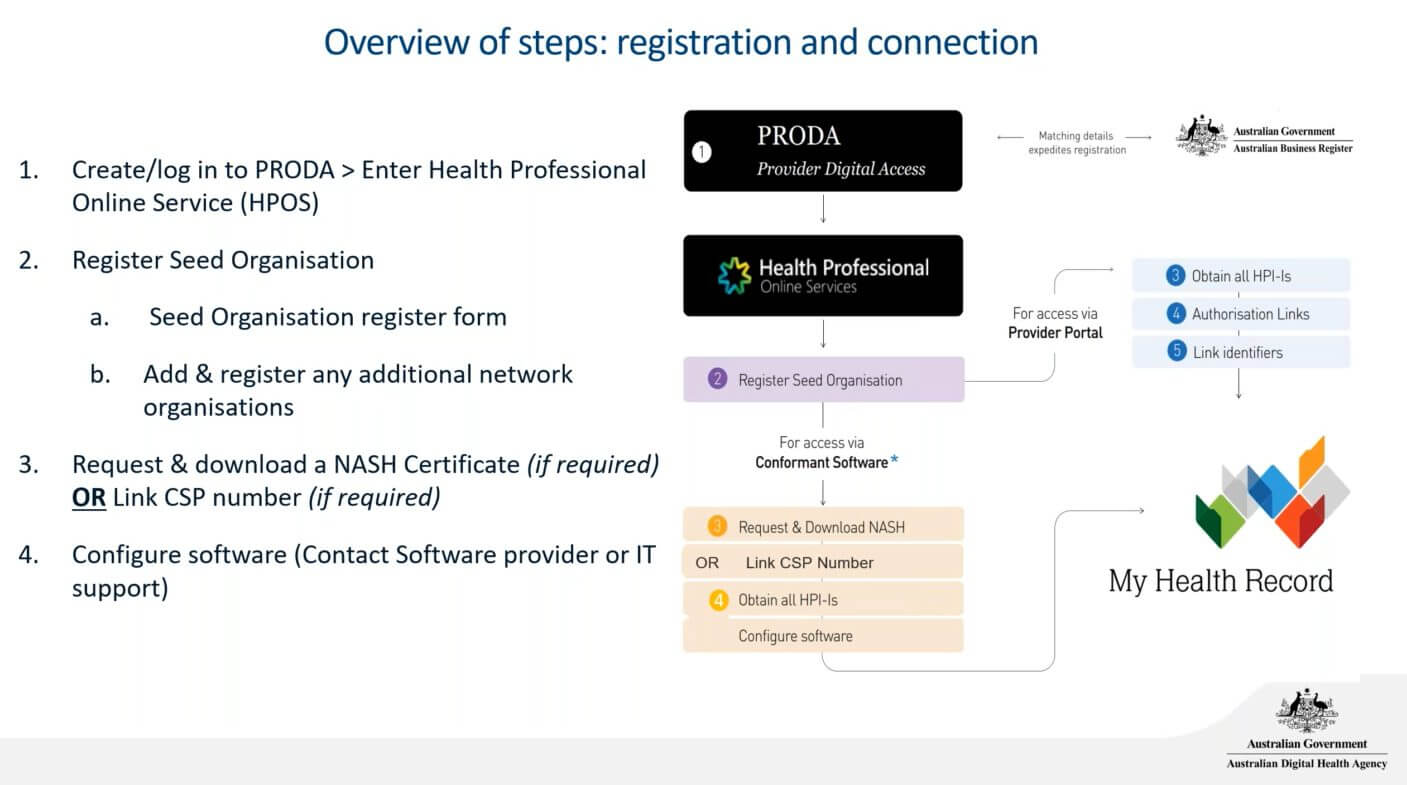
Where to get more help
For queries on the NSQHS Standards and requirements for your health service please contact AdviceCentre@safetyandquality.gov.au or 1800 304 056
For help with understanding how to implement My Health Record in day hospitals or private surgeries, please contact help@digitalhealth.gov.au









